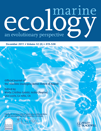Life in the Mid Atlantic
Life in the Mid Atlantic Bergen Museum : University of Bergen , 2009 . 240 pp. ISBN 82-7887-038-1 . Hardback: UK£22.50 on http://www.amazon.co.uk
Discoveries of the Census of Marine Life Making Ocean Life Count Cambridge : Cambridge University Press , 2010 . 270 pp. ISBN 978-1-107-00013-1 , Hardback, UK£60, US$99; ISBN 978-0-521-16512-9, paperback, UK£27.99, US$45 .
Grasping the biodiversity in the marine environment and getting the results across…
Three fundamental questions of science are: what do we know, what must we do, and what can we hope for? The first of the trilogy seems best anchored in the scientific process and to be the most straightforward. Unsurprisingly, scientists are among the first to admit that we actually don’t know very much at all. This, of course, hampers proceeding to the next two ‘questions’. In the biological sciences this discrepancy is perhaps nowhere more evident than when dealing with life in the sea. Extracting information from the sea is difficult and expensive, but without this information the next steps in this field remain tentative.
This lack of knowledge about life in the world’s largest ecosystem – and the recognition that the seas are truly threatened in a myriad of ways – was clearly a major factor in prompting the ambitious ‘Census of Marine Life’ (CoML) project, begun in 2000. Paul Snelgrove’s book makes a grand effort to synthesize – in a mere 270 pages – the work of 2700 scientists from 80 nations working in 17 different international projects. The 500+ research expeditions yielded 28 million specimens, including over 1000 new species.
How to convey such information and statistics, and to whom? An increasingly important facet of scientific research is interfacing with the educated public and, thankfully, books remain a part of this strategy. Both books reviewed here are such efforts: both are hybrids, somewhere between science text, popular science book, and educational text. They are not traditional science books, which, however, expands rather than narrows their merit.
Conducting a census in the marine environment requires expensive machinery and instruments. Both books highlight this, Boyle in the chapter ‘Ships and equipment’, Snelgrove in ‘New ways of seeing deeper and farther’ (Chapter 4). The great technological advances behind the various discoveries are a recurring theme in the various book sections.
The different approaches and the results they have provided are astounding indeed: new electronic tags permitted tracking organisms across the oceans, delivered physiological data and GPS readings and transmitted them via satellite. Other dense sensor arrays enabled individual organisms to be counted precisely as they massively migrated in the ocean.
Nonetheless, despite all this technology, many marine biologists continue to get wet, whether it be SCUBA diving in coral reefs, tagging seals on ice floes, traversing the intertidal in boots, or just sorting captured material out of nets by hand (Snelgrove, Fig. 5.2, pp. 98–99). The organisms they saw and collected are illustrated in glorious photographs in both books, many from depths and habitats we knew little about only a few decades ago. Interestingly, Boyle, in the chapter ‘Impressions of nature’, provides an unexpected insight into the way the visual record has been established, including scientific illustrators and artists past and present, juxtaposed to modern photographic techniques.
Peter Boyle’s book describes a regional effort (Atlantic, MAR-ECO, 2000–2010) to explore biodiversity in one of the greatest geographical features on the planet, the mid-ocean ridge habitat. Even such regional efforts can boast impressive statistics – an 11,000-km cruise track between Iceland and the Azores along with 80,000 biological specimens – and are truly international affairs: 35 scientists from 13 countries spent 2 months on the newly commissioned research vessel RV G.O.Sars. The narrative stretches from the surface down to the Mid-Atlantic Ridge. This bathyal ridge habitat is less well studied than continental slopes (of approximately equal surface area) and has also received little attention compared to much smaller habitats such as seamounts and hydrothermal vents.
The MAR-ECO tally of scientific papers – including special issues and a monograph on biogeography – has hit 300 and continues to rise. In 2007, the project won the CoML Outstanding Achievement Award for ‘overall excellence’, in competition with all other CoML initiatives. This was accompanied by the 2006 EU Descartes Prize for excellence in science communication. Importantly, the project has educated a number of students at all levels and has had a demonstrable societal impact: some of the patterns revealed were used to propose and introduce high-seas area closures and MPAs (Northeast Atlantic Fisheries Commission, NEAFC, and the Oslo-Paris Commission, OSPAR), i.e. some of the largest closures in the world ocean. The program found continuity in the UK ECOMAR cruises, and a spin-off project is currently underway in the South Atlantic led by Brazil.
Ultimately, the CoML and the MAR-ECO program (as one of many) have yielded much information, enlarging upon what Snelgrove calls ‘the known’– from another trilogy ‘the known, the knowable and the unknowable’, which Boyle’s book also starts off with (p. 9). These are crucial steps forward in making sense out of the ‘riot of species from microbes to whales’ (Chapter 3, Snelgrove, 2010). Much remains unknown, some probably unknowable, at least in the immediate future (p. 241). Sadly, the unknowable also refers to the fact that some of the unknown marine species will probably become extinct without us ever seeing them.
However, the next step in the trilogy of questions (‘what must we do’) can and must be taken now: waiting for complete knowledge is not an option. The MPAs and closures mentioned above are strong actions. Finally, what can we hope for? – that all this knowledge is not for naught and that the actions we can take today will halt the steady decline of marine ecosystems worldwide. This means not only collecting the data but also disseminating them as widely as possible, something these two books do admirably.




